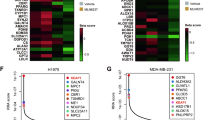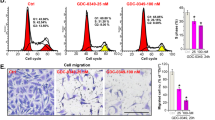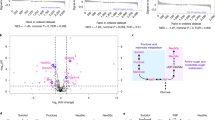Abstract
Continuous de novo fatty acid synthesis is a common feature of cancer that is required to meet the biosynthetic demands of a growing tumor. This process is controlled by the rate-limiting enzyme acetyl-CoA carboxylase (ACC), an attractive but traditionally intractable drug target. Here we provide genetic and pharmacological evidence that in preclinical models ACC is required to maintain the de novo fatty acid synthesis needed for growth and viability of non-small-cell lung cancer (NSCLC) cells. We describe the ability of ND-646—an allosteric inhibitor of the ACC enzymes ACC1 and ACC2 that prevents ACC subunit dimerization—to suppress fatty acid synthesis in vitro and in vivo. Chronic ND-646 treatment of xenograft and genetically engineered mouse models of NSCLC inhibited tumor growth. When administered as a single agent or in combination with the standard-of-care drug carboplatin, ND-646 markedly suppressed lung tumor growth in the Kras;Trp53−/− (also known as KRAS p53) and Kras;Stk11−/− (also known as KRAS Lkb1) mouse models of NSCLC. These findings demonstrate that ACC mediates a metabolic liability of NSCLC and that ACC inhibition by ND-646 is detrimental to NSCLC growth, supporting further examination of the use of ACC inhibitors in oncology.
This is a preview of subscription content, access via your institution
Access options
Subscribe to this journal
Receive 12 print issues and online access
$209.00 per year
only $17.42 per issue
Buy this article
- Purchase on Springer Link
- Instant access to full article PDF
Prices may be subject to local taxes which are calculated during checkout






Similar content being viewed by others
References
Vander Heiden, M.G., Cantley, L.C. & Thompson, C.B. Understanding the Warburg effect: the metabolic requirements of cell proliferation. Science 324, 1029–1033 (2009).
Hanahan, D. & Weinberg, R.A. Hallmarks of cancer: the next generation. Cell 144, 646–674 (2011).
Kuhajda, F.P. Fatty acid synthase and human cancer: new perspectives on its role in tumor biology. Nutrition 16, 202–208 (2000).
Menendez, J.A. & Lupu, R. Fatty acid synthase and the lipogenic phenotype in cancer pathogenesis. Nat. Rev. Cancer 7, 763–777 (2007).
Currie, E., Schulze, A., Zechner, R., Walther, T.C. & Farese, R.V. Jr. Cellular fatty acid metabolism and cancer. Cell Metab. 18, 153–161 (2013).
Wakil, S.J. & Abu-Elheiga, L.A. Fatty acid metabolism: target for metabolic syndrome. J. Lipid Res. 50, S138–S143 (2009).
McGarry, J.D., Leatherman, G.F. & Foster, D.W. Carnitine palmitoyltransferase I. The site of inhibition of hepatic fatty acid oxidation by malonyl-CoA. J. Biol. Chem. 253, 4128–4136 (1978).
Zhang, F. & Du, G. Dysregulated lipid metabolism in cancer. World J. Biol. Chem. 3, 167–174 (2012).
Steinberg, G.R. & Kemp, B.E. AMPK in health and disease. Physiol. Rev. 89, 1025–1078 (2009).
Fogarty, S. & Hardie, D.G. Development of protein kinase activators: AMPK as a target in metabolic disorders and cancer. Biochim. Biophys. Acta 1804, 581–591 (2010).
Swinnen, J.V. et al. Mimicry of a cellular low-energy status blocks tumor cell anabolism and suppresses the malignant phenotype. Cancer Res. 65, 2441–2448 (2005).
Zadra, G. et al. A novel direct activator of AMPK inhibits prostate cancer growth by blocking lipogenesis. EMBO Mol. Med. 6, 519–538 (2014).
O'Brien, A.J. et al. Salicylate activates AMPK and synergizes with metformin to reduce the survival of prostate and lung cancer cells ex vivo through inhibition of de novo lipogenesis. Biochem. J. 469, 177–187 (2015).
Fullerton, M.D. et al. Single phosphorylation sites in Acc1 and Acc2 regulate lipid homeostasis and the insulin-sensitizing effects of metformin. Nat. Med. 19, 1649–1654 (2013).
Brusselmans, K., De Schrijver, E., Verhoeven, G. & Swinnen, J.V. RNA-interference-mediated silencing of the acetyl-CoA carboxylase alpha gene induces growth inhibition and apoptosis of prostate cancer cells. Cancer Res. 65, 6719–6725 (2005).
Chajès, V., Cambot, M., Moreau, K., Lenoir, G.M. & Joulin, V. Acetyl-CoA carboxylase alpha is essential to breast cancer cell survival. Cancer Res. 66, 5287–5294 (2006).
Beckers, A. et al. Chemical inhibition of acetyl-CoA carboxylase induces growth arrest and cytotoxicity selectively in cancer cells. Cancer Res. 67, 8180–8187 (2007).
Tong, L. & Harwood, H.J. Jr. Acetyl–coenzyme A carboxylases: versatile targets for drug discovery. J. Cell. Biochem. 99, 1476–1488 (2006).
Harriman, G. et al. Acetyl-CoA carboxylase inhibition by ND-630 reduces hepatic steatosis, improves insulin sensitivity and modulates dyslipidemia in rats. Proc. Natl. Acad. Sci. USA 113, E1796–E1805 (2016).
Savage, D.B. et al. Reversal of diet-induced hepatic steatosis and hepatic insulin resistance by antisense oligonucleotide inhibitors of acetyl-CoA carboxylases 1 and 2. J. Clin. Invest. 116, 817–824 (2006).
Harada, N. et al. Hepatic de novo lipogenesis is present in liver-specific ACC1-deficient mice. Mol. Cell. Biol. 27, 1881–1888 (2007).
Gandhi, L. et al. Sunitinib prolongs survival in genetically engineered mouse models of multistep lung carcinogenesis. Cancer Prev. Res. (Phila.) 2, 330–337 (2009).
Zinszner, H. et al. CHOP is implicated in programmed cell death in response to impaired function of the endoplasmic reticulum. Genes Dev. 12, 982–995 (1998).
Little, J.L., Wheeler, F.B., Fels, D.R., Koumenis, C. & Kridel, S.J. Inhibition of fatty acid synthase induces endoplasmic reticulum stress in tumor cells. Cancer Res. 67, 1262–1269 (2007).
Cho, Y.S. et al. Molecular mechanism for the regulation of human ACC2 through phosphorylation by AMPK. Biochem. Biophys. Res. Commun. 391, 187–192 (2010).
Shen, Y., Volrath, S.L., Weatherly, S.C., Elich, T.D. & Tong, L. A mechanism for the potent inhibition of eukaryotic acetyl–coenzyme A carboxylase by soraphen A, a macrocyclic polyketide natural product. Mol. Cell 16, 881–891 (2004).
Wei, J. & Tong, L. Crystal structure of the 500-kDa yeast acetyl-CoA carboxylase holoenzyme dimer. Nature 526, 723–727 (2015).
Munday, M.R., Campbell, D.G., Carling, D. & Hardie, D.G. Identification by amino acid sequencing of three major regulatory phosphorylation sites on rat acetyl-CoA carboxylase. Eur. J. Biochem. 175, 331–338 (1988).
Lee, W.N., Bassilian, S., Lim, S. & Boros, L.G. Loss of regulation of lipogenesis in the Zucker diabetic (ZDF) rat. Am. J. Physiol. Endocrinol. Metab. 279, E425–E432 (2000).
Shackelford, D.B. et al. LKB1 inactivation dictates therapeutic response of non-small-cell lung cancer to the metabolism drug phenformin. Cancer Cell 23, 143–158 (2013).
Jeon, S.M., Chandel, N.S. & Hay, N. AMPK regulates NADPH homeostasis to promote tumor cell survival during energy stress. Nature 485, 661–665 (2012).
Wang, C. et al. Acetyl-CoA carboxylase alpha inhibitor TOFA induces human cancer cell apoptosis. Biochem. Biophys. Res. Commun. 385, 302–306 (2009).
Camarda, R. et al. Inhibition of fatty acid oxidation as a therapy for MYC-overexpressing triple-negative breast cancer. Nat. Med. 22, 427–432 (2016).
Harriman, G.C., Masse, C.E., Harwood, H.J. Jr., Baht, S. & Greenwood, J.R. ACC inhibitors and uses thereof. US patent 8,969,557 (2015).
Metallo, C.M. et al. Reductive glutamine metabolism by IDH1 mediates lipogenesis under hypoxia. Nature 481, 380–384 (2011).
Lewis, C.A. et al. Tracing compartmentalized NADPH metabolism in the cytosol and mitochondria of mammalian cells. Mol. Cell 55, 253–263 (2014).
Fernandez, C.A., Des Rosiers, C., Previs, S.F., David, F. & Brunengraber, H. Correction of 13C mass isotopomer distributions for natural stable isotope abundance. J. Mass Spectrom. 31, 255–262 (1996).
Ran, F.A. et al. Genome engineering using the CRISPR–Cas9 system. Nat. Protoc. 8, 2281–2308 (2013).
Ran, F.A. et al. Double nicking by RNA-guided CRISPR–Cas9 for enhanced genome-editing specificity. Cell 154, 1380–1389 (2013).
McCabe, D.C., Rajakumar, B., Marshall, P., Smith, I.W. & Ravishankara, A.R. The relaxation of OH (v = 1) and OD (v = 1) by H2O and D2O at temperatures from 251 to 390 K. Phys. Chem. Chem. Phys. 8, 4563–4574 (2006).
Yang, D. et al. Assay of low deuterium enrichment of water by isotopic exchange with [U-13C3]acetone and gas chromatography–mass spectrometry. Anal. Biochem. 258, 315–321 (1998).
Lee, W.N. et al. In vivo measurement of fatty acids and cholesterol synthesis using D2O and mass isotopomer analysis. Am. J. Physiol. 266, E699–E708 (1994).
Acknowledgements
This study was supported by grants from the US National Institutes of Health (NIH) (grant no. R01CA172229 (R.J.S.), P01CA120964 (R.J.S.) and R01CA188652 (C.M.M.)), the Samuel Waxman Cancer Research Foundation (R.J.S.), The Leona M. and Harry B. Helmsley Charitable Trust (grant no. 2012-PG- MED002; R.J.S.) and the US Department of Defense (grant no. W81-XWH-13-1-01-5; C.M.M. and R.J.S.). R.U.S. was supported by a postdoctoral fellowship from the American Cancer Society (ACS#124183-PF-13-023-01-CSM). L.J.E. was supported by a T32 postdoctoral training grant to the Salk Institute Cancer Center (5 T32 CA009370) and a postdoctoral fellowship from the American Cancer Society (PF-15-037-01-DMC). S.J.P. was supported by an F31 NIH predoctoral training fellowship (F31CA196066-01). M.J.K. is supported by a UCSD Medical Scientist Training Program fellowship (2 T32 GM007198). P.S.L. was supported by a T32 predoctoral training grant (T32 GM 007240). S.N.B. is supported by a T32 postdoctoral training grant to the Salk Institute Cancer Center (T32: 5T32CA009370-33). J.L.V.N. is supported by a Damon Runyon Cancer Research Foundation fellowship (DRG-2219-15). We thank K. McIntyre and the histology core at the Salk Institute, which is also supported in part through the Salk CCSG P30 CA014195 grant, as well as the next-generation sequencing (NGS) core facility at the Salk Institute, which is supported with funding from the NIH–NCI CCSG P30 014195 grant, the Chapman Foundation, the Glenn Foundation and the Helmsley Charitable Trust. We also thank R. Farid for Figure 2b, E. Smith for Figure 2j, G. Wahl for the p53-specific antibody used in the IHC experiments and P. Hollstein for technical assistance.
Author information
Authors and Affiliations
Contributions
R.U.S. and R.J.S. designed the experiments and wrote the manuscript with input from all authors; R.U.S. performed all experiments, except as noted; P.S.L. and J.L.V.N. assisted with the CRISPR–Cas9 studies in Figure 1; S.J.P. and C.M.M. performed the FASyn analysis (Figs. 1 and 3) and, with help from M.W., analyzed FASyn in the tumors prepared by R.U.S. in Figure 5; M.J.K. and A.S. performed the FFA analysis for Figures 5 and 6; L.J.E. performed the IHC and tumor-burden analysis in Figures 4 and 6; S.N.B., L.V., L.G. and A.H. assisted with dosing in the in vivo experiments in Figures 4 and 6; G.H., W.F.W., J.G., S.B., H.J.H. and R.K. discovered and developed the series of ACC inhibitors that contains ND-646 and ND-608, conducted the enzyme inhibition and pharmacokinetic characterization of both compounds, and conducted the molecular modeling studies (Fig. 2b,i).
Corresponding authors
Ethics declarations
Competing interests
J.G. and S.B. are employed by Schrödinger; G.H., W.F.W., H.J.H. and R.K. are employed by Nimbus Therapeutics.
Supplementary information
Supplementary Text and Figures
Supplementary Figures 1–6 and Supplementary Note 1 (PDF 53789 kb)
Rights and permissions
About this article
Cite this article
Svensson, R., Parker, S., Eichner, L. et al. Inhibition of acetyl-CoA carboxylase suppresses fatty acid synthesis and tumor growth of non-small-cell lung cancer in preclinical models. Nat Med 22, 1108–1119 (2016). https://doi.org/10.1038/nm.4181
Received:
Accepted:
Published:
Issue Date:
DOI: https://doi.org/10.1038/nm.4181
This article is cited by
-
The translational potential of miR-26 in atherosclerosis and development of agents for its target genes ACC1/2, COL1A1, CPT1A, FBP1, DGAT2, and SMAD7
Cardiovascular Diabetology (2024)
-
Reprogramming of lipid metabolism in the tumor microenvironment: a strategy for tumor immunotherapy
Lipids in Health and Disease (2024)
-
Oxyhaemoglobin saturation NIR-IIb imaging for assessing cancer metabolism and predicting the response to immunotherapy
Nature Nanotechnology (2024)
-
Lipid metabolic reprogramming in tumor microenvironment: from mechanisms to therapeutics
Journal of Hematology & Oncology (2023)
-
Prognosis-related molecular subtyping in head and neck squamous cell carcinoma patients based on glycolytic/cholesterogenic gene data
Cancer Cell International (2023)



